Summary: The latest reforms pushed by Prime Minister Narendra Modi reverse not just a seven-decade-old stifling policy framework but a seven-century old cycle of impoverishing India’s farmers and by consequence the rural economy. These reform bills are the outcome of two-decade long consultation process and a bipartisan consensus
(This article was first published in Organiser. Republished with permission)
Prime Minister Narendra Modi in a speech in August earlier this year succinctly summed up the crux of the issue bed-welling with the farming sector. He said, “Just as industries have the freedom to fix the price of their produce and sell it anywhere in the country, why can’t farmers get such a facility too?”
To understand what this means in practice, think of a world where a producer of a good or service is told that you put in your own money, utilise your specialised know-how, put in your hard labour, create your own storage capacity and manage your own transport for producing and transporting the good that you want to market. One would think that is standard practice, right? That every producer does precisely the same thing.
However, what would be your reaction when you are then told that the producer of such finished good has been told that where you sell, how much you sell and at what price you sell will be decided not by you but by us, a group of people who are neither producers nor consumers but just a group of strong-arm middlemen who are insisting on this way, because we can.
Would not the first reaction of anyone when told of a such a system would be that of incredulous disbelief? Sure, some may argue, that such systems existed in the medieval ages but do they still exist now? For now, the argument would be, in the modern times the entire systems have evolved everywhere in the world and producers of goods, and indeed services, are free to sell their produce wherever they want and to whoever they want and at whatever price they can command. Sound logical right? Except that it was not so for Indian farmers, who constitute more than India’s 50% workforce.
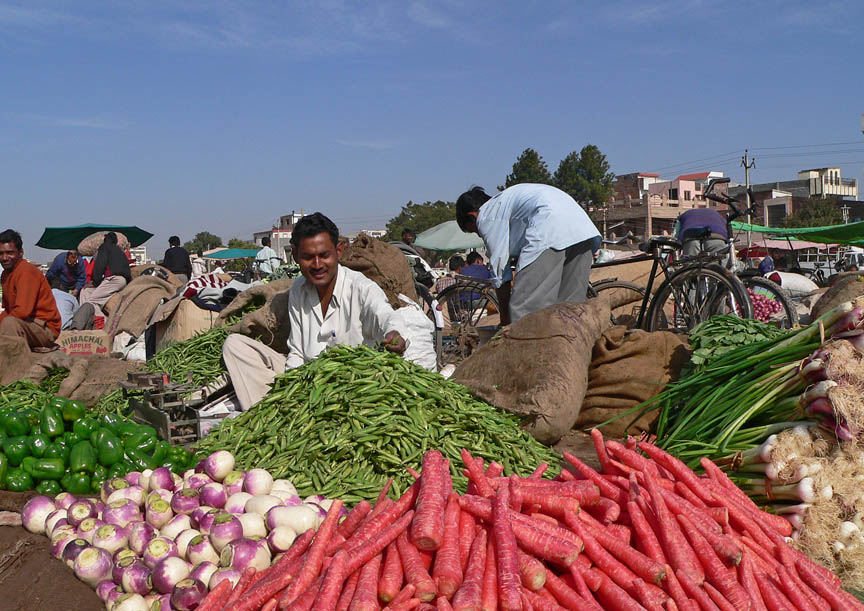
Roots of the Historical Wrong
It is quite ironical that even 70 years after Independence, India was continuing with a system in agriculture which was not just medieval in method and practice but was actually first introduced in the medieval period itself. Alauddin Khilji, the Turkic invader who ruled India in the 14th century, first introduced the trade and price control policies to support his large and marauding army and enrich the Turkic nobility. Later, East India Company during the late 18th and early 19th century further chained the freedom of the farmers by forcing them to grow Indigo and Opium and then sell it dirt cheap rates. A few decades later, The British, now ruling directly, followed the same policy to procure cheap cotton for their mills in Manchester. In 1887, they even promulgated an act that has survived in one form or the other till recently.
The end result, the Indian farmers — who had created a prosperous nation that lasted more than multiple millennia — were impoverished within a few centuries and the rural economy completely decimated. A country with no significant record of famine or deprivation during the dark centuries of Europe was suddenly facing a devastating famine every few decades!
One would have thought that with India gaining Independence in 1947, the first order of business would have been to dismantle these destructive policies. The reverse happened. The 1887 British predatory law took rebirth as the Essential Commodities Act (ECA), and the state-level Agricultural Produce Marketing Committee (APMC) Act in 1955.
The ECA act was used to control production, supply, trade, and storage of commodities arbitrarily deemed essential. The APMC act forced the farmers to sell their produce only through designed channels and mandis (markets) and prevented trading outside their local area. So, soon after Independence, while the nation had been politically integrated after great efforts by Sardar Patel, the agriculture market was by design fragmented into a thousand pieces!
The net result of these policies, promulgated in a free India, were ironically the same that the policies of Khilji had seven centuries ago. A small, connected group of middlemen emerged, who monopolised the entire farm trade. The farmer got a pittance for his produce, since it was a monopoly buyer situation, while the consumer often faced high prices for essential items. The intervening layers of middlemen, controlled by politicians, were the big fat earners.
It is in this context that we need to understand the three reform bills passed by India Parliament that completely dismantled this unholy nexus. Let us understand the background to these reforms, the need for these reforms and the almost two-decade-long consultation process for these reforms.
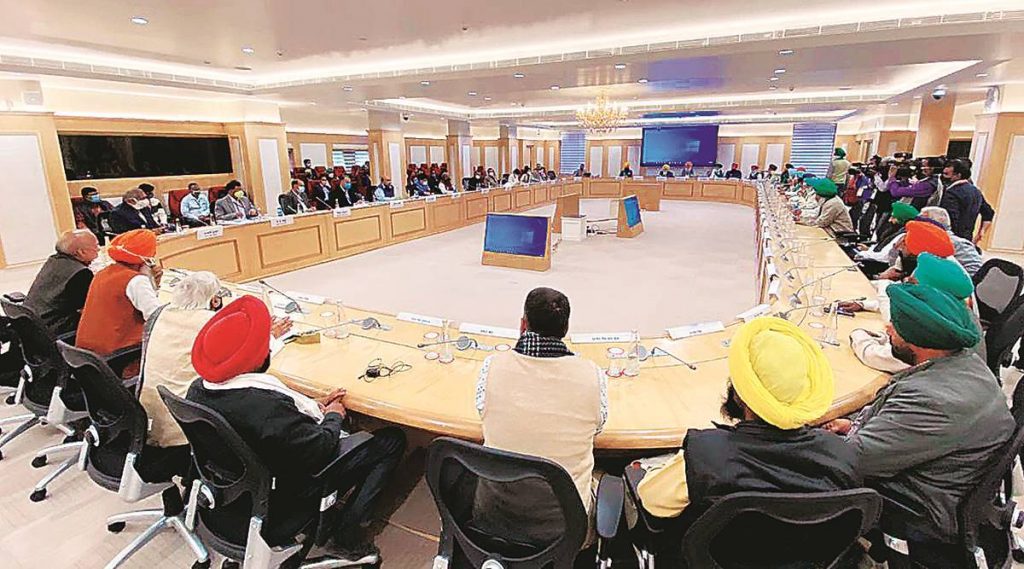
Background – The Income Disparity
While the farmers have made India extremely productive with their sweat and toil, the issue of profitability in the agriculture sector was always being side-lined. The reforms in agriculture and agricultural markets would upset cartels of middlemen and therefore were never attempted with any serious attempt.
Despite economic liberalisation starting during the nineties, agriculture as a sector was left out. What was the outcome of this? Consider this data point. The difference in the annual income of Farmer and Non-Farm worker, which stood at Rs 25,398 in 1993-94 further widened to Rs 54,377 in 1999-2000 and, in the next decade, it further increased to more than Rs 1.42 lakh. Or consider that the dairy and fisheries sector where government intervention is minimal is growing at an annual rate of 4% to 10%, while the growth in the food grain sector, where regulations have been excessive, has been at an average of 1.1% annually after 2011-12. Hence, it was always known that agriculture sector too needed pro-farmer reforms, just like the reforms in other sectors, to increase the income of farmers.
The Challenges for Farming Sector
Due to the previous non-attempts to fundamentally reform the agriculture sector, several challenges arose that held the sector back. Some of these challenges are:
- Fragmented Markets: Each market functioned as a separate entity, hampering intra as well as interstate trade.
- Insufficient Markets: At the same time, there were not enough markets to deal with growing produce.
- Market Fees & Charges: Taxes, various commissions raised the cost of the final product, while reducing returns to farmers
- Inadequate Infrastructure: Despite market taxes, infrastructure in markets remained underdeveloped and not tune with modern supply chains
- Post-Harvest Losses: This inadequate infrastructure led to high post-harvest losses, estimated at as much as Rs 90,000+ crore in 2014
- Restriction in Licensing: Entry as a licensed agent was restricted, discouraging competition and encouraging cartelisation
- High Intermediation Costs: The fragmented system led to high intermediation costs, raising costs for consumers, while depressing prices received by farmers depressing prices received by farmers
- Information Asymmetry: Farmers often lacked market information, which traders & commission agents withheld from farmers
- Inadequate Credit Facilities: Informal credit channels still dominated formal channels.
A Two Decade process of Consultation
Many ill-informed voices are arguing that these bills were brought in haste without any consultation. The reality is, extensive consultation that has taken place since that last two decades and more in the run-up to the enactment of these three farm bills. The current bills are perhaps are the only reforms in India for which more than two decades of consultations have taken place in various forms, and under multiple governments, and all have been moving progressively in the same direction.
The process of consultation started when the then Ministry of Agriculture, under the NDA government led by Prime Minister Vajpayee, appointed an Expert Committee in December 2000 under the Chairmanship of Shankarlal Guru, to review and recommend measures to make agriculture marketing system more efficient and competitive. The Report of the Expert Committee on Strengthening and Developing of Agriculture Marketing, 2001 said, “the institution of regulated market, has, however, achieved a limited success. Over a period of time, these markets have, however, acquired the status of restrictive and regulated markets, providing no help in direct and free marketing…”.
This process continued under the UPA government when they followed up with states to adopt the model 2004 APMC law and even framed new rules and regulations in 2007. Other forms of expert group consultations were taking place simultaneously. National Commission on Agriculture chaired by noted and respected scientist M.S. Swaminathan submitted its report in 2006, which recommended promotion of Unified National Market.
In March 2010, then Minister for Agriculture in UPA government, Sharad Pawar, constituted an Empowered Committee under the Chairmanship of Agriculture Minister of the Government of Maharashtra and 10 State Ministers. This Committee, in its report in 2013, suggested simplification of procedure of contract farming, barrier-free national markets, waiving off of market fee on fruits and vegetables, among other things. The Committee also made the recommendation to “develop a National Single Market for agricultural produce, by removing all the existing physical, legal, and statutory barriers”. It also recommended a Central Legislation to deal with “Inter-State Agricultural Marketing, promotion of agribusiness, trade and commerce at the national level”.
The NDA government, led by Prime Minister Modi assumed office in 2014. On states’ persistent request for some model template, Ministry of constituted Dalwai Committee to formulate such a Model Act, with members from the States of Odisha, Bihar, Rajasthan, Telangana Uttar Pradesh. The Committee after extensive consultation recommended adoption of The Model APLM Act, 2017 in April 2017. This Committee also recommended, among other things, the promotion of the national market for agriculture produce. The Adoption of this Model APLM Act, 2017 happened in West Bengal (TMC), Punjab (Congress), Uttar Pradesh, Arunachal Pradesh and Haryana, pointing out the across the political spectrum nature of the consensus.
In order to protect the interests of farmers in Contract Farming, again Dalwai Committee was set up which had representation from states of Punjab, Maharashtra, Odisha, Karnataka, Madhya Pradesh.
It is the process of this long and bipartisan consultation and consensus, spread over two decades, and under various governments, that finally led to the three new farm laws passed earlier this year. Therefore, it is clear that the charge that these laws were passed in a hurry, or without consultation is patently untrue.
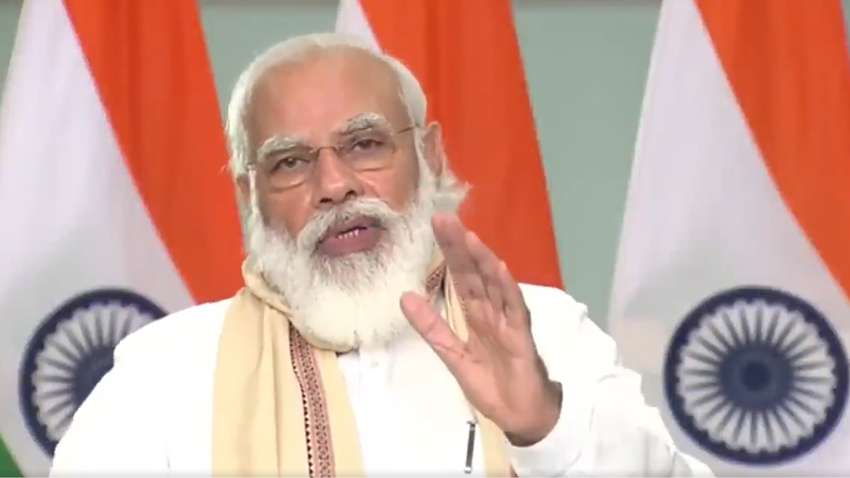
Revolutionary Empowerment of Farmers
At the outset, it is essential to note that these reforms do not dismantle the existing structure of State APMC Mandis. The Mandis will remain, and the farmers will be free to sell in the existing Mandis as they currently do. The MSP structure is also not being dismantled. The MSP system will continue and indeed, even after these three reforms were announced, the Modi government has increased MSP and then made record procurements at the newly increased rates.
Features of Farmers’ Produce Trade and Commerce (Promotion and Facilitation) Act, 2020 – The Creation of the National Market Bill• Intra and Inter-State Trade of farmers produce beyond the physical premises of the existing markets.
A. Trade can be conducted at any place of convenience of the farmer, like:
- APMC Mandi
- farm gate
- factory premises
- warehouses
- silos
- cold storages
B. Permits online trading of farmers produce, allowing farmer organisations and private sector companies to set up their own electronic trading platforms.
Features of Farmers (Empowerment and Protection) Agreement of Price Assurance and Farm Services Act, 2020-The Contract Farming Bill
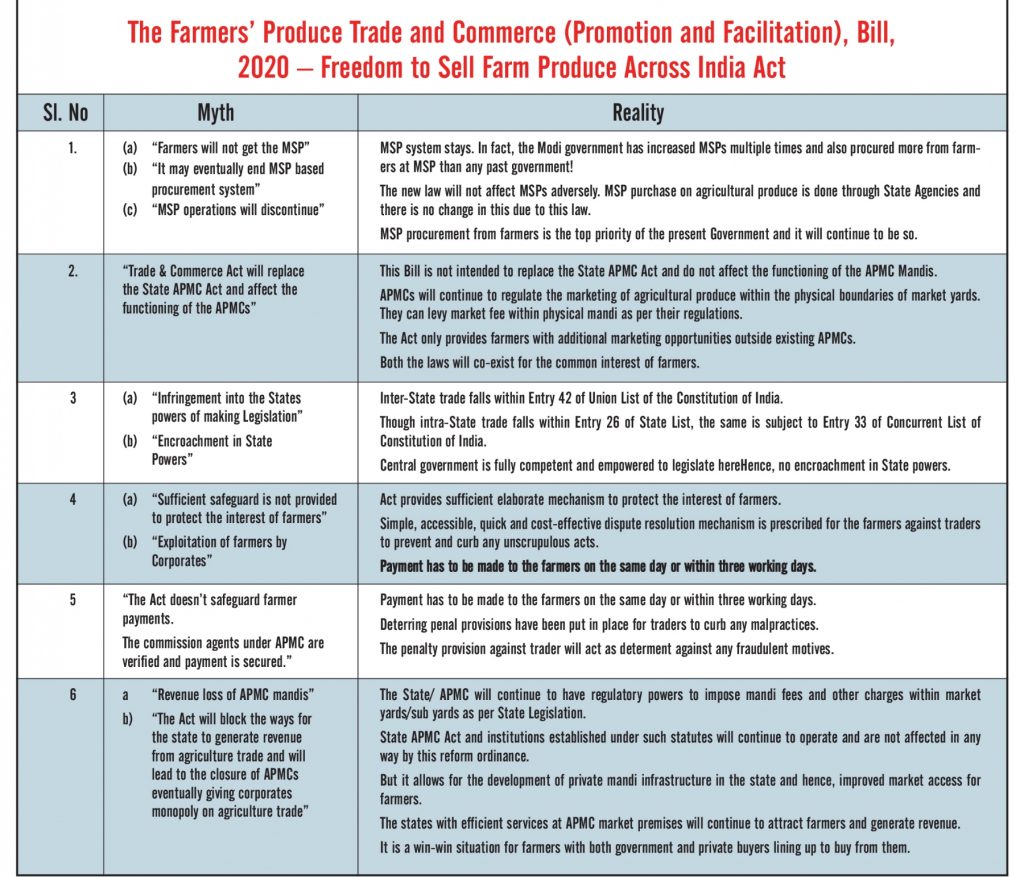
- Farming agreements between farmers and buyers are made possible, for production or rearing of any farm produce.
- The price of the produce will be clearly mentioned in the contract.
- A specified dispute resolution mechanism, protecting the rights of both farmers and buyers. Features of The Essential Commodities (Amendment) Act, 2020
- The Central Government may only invoke the provisions of the Essential Commodities Act, 1955 in an extraordinary situation (war, famine, extraordinary price rises and natural calamities)
- Imposition of stock limits must only be based on price rises, and can only be imposed if there is a 100% increase in the retail price of horticultural produce and a 50% increase in the retail price of non-perishable produce
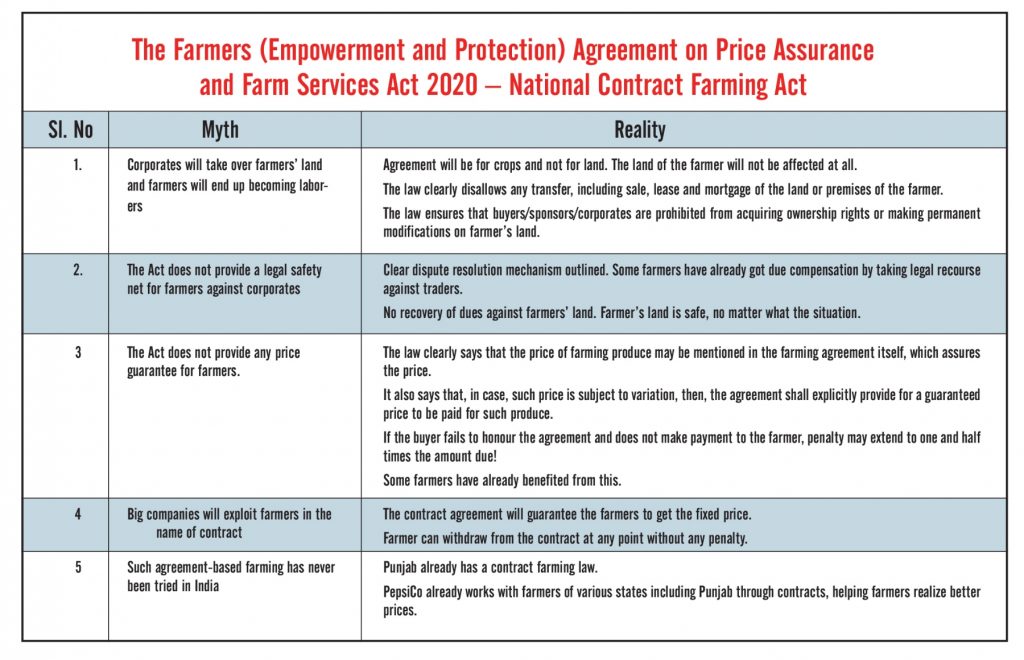
Impact of Reforms
Modi government has set itself the goal of doubling farmers’ income which necessitated initiatives and reforms must focus on creating more income opportunities and better market access for farmers. The reforms were undertaken in September 2020 ensure precisely that.
- For every product and for every producer, all of India is a single unified market. Only farmers were denied this benefit of a massive market.
- With these reforms, Indian farmers will now finally have the freedom to sell their produce to who they want and where they want, an option denied to them up until now.
- APMC Market yards will now face competition from other markets. This competition to buy from farmers means farmers have the greater bargaining power to decide their price.
- However, if farmers want to sell within the APMC markets or at MSP, even that is allowed. So, the MSP acts as a safety net for farmers.
- If farmers find buyers willing to buy from them at their doorstep, they can sell to them. They also have a legal framework protecting their rights when they do so. This provision saves farmers the time, money and effort of reaching markets.
- Farmers will no longer be bound to pay a long list of market fees, taxes, and cesses on their produce, thus, improving their returns.
- Development of infrastructure close to the farm-gate will reduce post-harvest losses, improve income through grading & sorting and boost linkages to terminal markets in food processing, retail, and exports.
- This will also lead to the development of better price discovery mechanisms for farmers, leading to a better price for their produce.
eNAM can finally fulfil its potential of serving as the national platform for electronic trading in agriculture produce. - Contract farming can act as a form of price assurance and will boost linkages with the food processing sector.
- These reforms will also boost investment in the agriculture sector, through better backward linkages, assured prices, and contracts for farm services.
- Bringing farmers together through Farmer Producer Organisations will enable bargaining capacity and economies of scale for even small farmers.
- The impact of these reforms will see India’s agriculture and food processing industries transformed. With India only processing 10% of its produce and commanding a share of 2.3% in global food exports, both these sectors will receive a much-needed fillip with a liberal procurement regime.
- Private sector investments will pour in across the entire cold chain, reducing post-harvest losses and ensuring better prices received by farmers.
- Better backward linkages will ensure a better quality of produce, leading India to capture a more significant share of global export markets. So, even the global markets will open up for Indian farmers.
- Employment in the food processing sector will rise, especially for the rural youth, and this will put India on the path towards becoming the leading food exporter in the world while maintaining our food security.
- Due to all of these effects, farming can become profitable even for small and marginal farmers.
- For decades, it was clear that reforms were required to ensure better market access and price assurance for farmers. States had to take the lead in instituting these reforms. Yet, very little was done in this direction in terms of meaningful action.
- These reforms were required to fulfil these long-standing demands of farmers for which there was a clear bipartisan political consensus.
- For too long, farmers had been held back by a restrictive regime. These reforms finally provide freedom to our farmers.
Modi’s Commitment to Indian Farmer
It is clear, therefore, that the three farm bills passed by India Parliament, earlier this year have been passed after extensive consultations in, which all stakeholders were on board; the laws will finally free the farmers from the unfair restrictions imposed on them; and will create a unified national market which will increase competition and thereby income opportunities for the farmers.
Prime Minister Modi has been one of the most consistent advocates of farm reforms and his life journey, and experience first as Chief Minister of Gujarat and then as Prime Minister of India are a testimony to this fact. As Chief Minister of Gujarat, he led the state in achieving double-digit growth in agriculture sector for successive years which created the base of growth of the state. It was his record of understanding the pulse of the farming sector that led to him innovating many new policies that propelled the farming sector. He brings the same experience in his Prime Ministerial stint and the record in the last six years are proof of that same commitment. Some of the measures taken since 2014 bear out that the farming sector has always been the top focus for Modi government and his push to double farm incomes are not just statements but actual policy. Take budgetary allocations, for instance. How much you spend on a sector are the firmest proof of your intention. In the year 2013-14, the Budget allocation for the Department of Agriculture was only Rs. 21,933.50 crore. In the year 2020-21, the Budget allocation has been increased by more than six times to Rs. 1,34,399.77 crore.
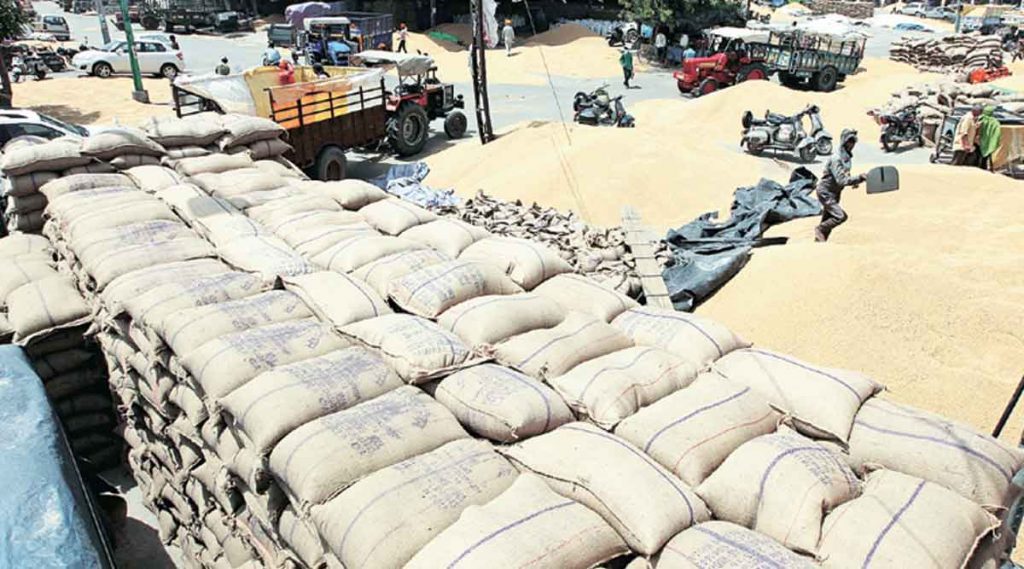
Or take the consistent focus of Modi government on not just increasing MSP but also procurement under MSP. MSP payment to farmers for paddy has risen by 2.4 times during the last five years in comparison to the period from 2009-10 to 2013-14. MSP payment of Rs 4.95 lakh crore has been made as against Rs 2.06 lakh crore of the previous five years. MSP payment to farmers for wheat has increased by 1.77 times during the last five years in comparison to the period from 2009-10 to 2013-14. MSP payment of Rs 2.97 lakh crore has been made as against Rs 1.68 lakh crore of the previous five years. MSP payment to farmers for pulses has increased by 75 times during the last five years in comparison to the period from 2009-10 to 2013-14. MSP Payment of Rs 49,000 crore has been made as against Rs 645 crore of the previous five years. MSP payment to farmers for oilseeds and copra has increased by ten times during the last five years in comparison to the period from 2009-10 to 2013-14. MSP Payment of Rs 2,5000 crore has been made as against Rs 2460 crore of the previous five years. The provision of PM Kisan, which provides the direct benefit of Rs, 6,000 per year to every farmer in India is another indicator of the deep understanding and sensitivity that the Prime Minister has towards our farmers. The amount is beneficial for the marginal and small farmer and contributes as an extra income for meeting many of his needs.
Future of Farming Sector
The latest reforms pushed by Prime Minister Narendra Modi, unmindful of any short-term political blowback by vested lobbies, are thus genuinely historic. They reverse not just a seven-decade-old stifling policy framework but in fact a seven-century old cycle of impoverishing India’s farmers and by consequence the rural economy.
The agriculture reforms are significant not just for India but for the larger world too. As free trade becomes a norm, income levels will rise in rural India, a population zone of over 600 million, there will demand of all kinds of goods and services. While this will undoubtedly contribute to India’s GDP growth, it will also be a significant opportunity for the producers of these goods and services, across the world, to cater to an entirely new market hitherto untouched.
(The author is CEO, Bluekraft Digital Foundation and was earlier Director, MyGov India)
